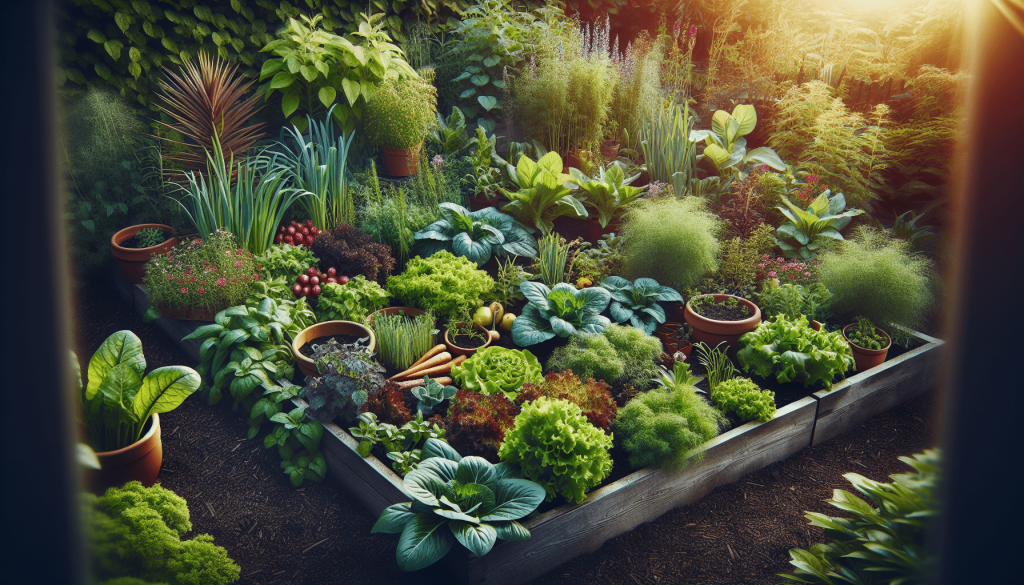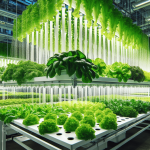This post may contain affiliate links. As an Amazon Associate, we may earn commissions from qualifying purchases.
Are you looking to take your gardening to the next level? Look no further than raised beds! These handy structures offer a multitude of benefits that can transform your gardening experience. From improved soil quality to easier maintenance and increased yield, raised beds are a game-changer for any aspiring green thumb. Let’s explore the various advantages of using raised beds for gardening and discover why they are a must-have for any passionate gardener.

Increased Soil Quality
Improved drainage
One of the major benefits of using raised beds for gardening is improved drainage. The elevated nature of raised beds allows excess water to drain more efficiently, preventing waterlogging and ensuring that plants do not suffer from root rot. This is especially beneficial in areas with heavy rainfall or clayey soil, where drainage can be a challenge.
Better soil structure
Another advantage of raised beds is that they promote better soil structure. The soil in raised beds tends to be looser and more friable compared to traditional garden beds. This loose soil structure allows plant roots to penetrate more easily, enabling them to access vital nutrients and oxygen. Additionally, the improved soil structure facilitates the movement of water and nutrients throughout the bed, promoting healthier plant growth.
Higher organic matter content
Raised beds also offer the opportunity to create a soil mix with a higher organic matter content. By incorporating compost, aged manure, or other organic materials into the soil, you can enhance its fertility and nutrient-holding capacity. This increased organic matter content provides a steady supply of nutrients to plants, supporting their growth and overall health.
Decreased soil compaction
The elevated nature of raised beds helps to minimize soil compaction. Traditional garden beds tend to become compacted over time due to foot traffic or heavy machinery. In contrast, the confined space of raised beds limits the area that can be compacted. The loose soil structure, combined with the absence of foot traffic, allows plant roots to grow more freely and prevents soil compaction, which can impede root development and reduce overall plant vigor.
Enhanced Pest Control
Reduced risk of soil-borne pests
Raised beds offer an advantage when it comes to pest control, particularly for soil-borne pests. The distinct boundaries of raised beds make it more difficult for pests to spread from one bed to another. This containment helps prevent the infestation of an entire garden, allowing you to focus your efforts on managing pests in specific areas. Additionally, raising the soil level can help to deter pests such as ground-dwelling insects or burrowing rodents.
Easier pest detection and management
The raised height of the beds makes pest detection and management easier. In traditional garden beds, pests may hide within the vegetation or soil, making them harder to spot and control. However, in raised beds, pests are more visible, as they are elevated above the ground level. This visibility allows for early pest detection and prompt intervention, such as handpicking, applying organic pest control methods, or installing physical barriers.
Physical barrier to crawling insects
Raised beds act as a physical barrier to crawling insects, providing an extra line of defense against pests such as slugs, snails, and ground-dwelling insects. The raised edges of the beds make it more challenging for these pests to access your plants, reducing the chances of damage. Additionally, you can further enhance this protective barrier by applying a layer of gravel or copper tape along the edges of the beds, which acts as a deterrent to pests.
Improved Weed Control
Reduced weed competition
One of the significant benefits of using raised beds is the reduced weed competition. Raised beds provide a defined space for your plants, making it easier to manage and control the growth of weeds. The barriers created by the raised edges help to restrict weeds from infiltrating your beds, reducing the need for frequent weeding and minimizing competition for resources such as sunlight, water, and nutrients.
Easier weed removal
Any weeds that do manage to find their way into your raised beds can be more easily removed. The loose and friable soil in raised beds allows for efficient weed removal, as the roots of the weeds are less likely to be tightly entwined with the soil. This makes the process of weeding less time-consuming and labor-intensive. Regular maintenance and proactive weed management will ensure that your plants have ample space and resources to thrive.
Prevention of spreading perennial weeds
Raised beds can also help prevent the spread of perennial weeds, which can be challenging to eradicate once established. By confining the growing area to raised beds, you can create a physical barrier that inhibits the lateral spread of perennial weed roots, preventing them from infiltrating your entire garden. This containment strategy simplifies weed management and reduces the long-term persistence of persistent and invasive weeds.
Extended Growing Season
Faster soil warming in spring
Raised beds can extend the growing season by facilitating faster soil warming in the spring. The elevated height of the beds allows them to warm up more quickly, as they receive more direct sunlight and are less affected by cooler ground temperatures. This accelerated soil warming promotes earlier planting and germination, giving your plants a head start in terms of growth and development.
Delayed soil cooling in fall
Similarly, raised beds can delay soil cooling in the fall, providing a longer growing season. The increased elevation of the beds helps retain heat absorbed during the day, preventing rapid cooling overnight. This prolonged warmth allows plants to continue thriving and producing for a longer period, even as temperatures drop. It can be particularly advantageous for extending the harvest of frost-sensitive crops into late fall or early winter.
Protection against late frosts
Raised beds also offer protection against late frosts, which can be detrimental to young seedlings or delicate plants. The elevated nature of the beds brings plants closer to eye level, making it easier to monitor for potential frost conditions. Additionally, you can cover the beds with floating row covers or cloches to provide additional insulation and protect your plants from frost damage.

Better Physical Accessibility
Reduced bending and kneeling
One of the most significant advantages of using raised beds is the reduced need for bending and kneeling. The increased height of the beds brings the gardening space closer to your reach, minimizing strain on your back and knees. This accessibility ensures that gardening remains enjoyable and comfortable, even for individuals with mobility issues or physical limitations.
Suitable for people with mobility issues
Raised beds are particularly suitable for people with mobility issues, as they eliminate the need to bend or kneel. Individuals with arthritis, limited mobility, or those who use mobility aids can easily access and tend to their garden without discomfort. The elevated height allows for seated gardening or gardening from a standing position, making it accessible to a wider range of individuals.
Ideal for older gardeners
Raised beds are also ideal for older gardeners who may experience challenges associated with traditional gardening methods. As we age, our physical abilities may change, and tasks that were once effortless may become more difficult. The raised height of the beds reduces the strain on joints and muscles, allowing older gardeners to continue pursuing their passion without excessive physical exertion.
Optimal Plant Growth
Control over soil composition
Using raised beds gives you complete control over the soil composition, allowing you to create an optimal growing environment for your plants. You can customize the soil mixture according to the specific needs of different plants, ensuring they receive the ideal balance of nutrients, organic matter, and pH levels. This control over soil composition optimizes plant growth and maximizes their potential for success.
Ideal root environment
Raised beds provide an ideal root environment for plants. The loose and well-draining soil, combined with improved aeration, allows roots to grow and expand more easily. Unrestricted by compacted soil or competing with weeds, plant roots can spread out and access nutrients and water more effectively. This results in stronger and healthier root systems, which in turn support vigorous plant growth and overall plant vitality.
Increased nutrient availability
One of the primary advantages of raised beds is the increased availability of nutrients for plants. By amending the soil with organic matter and incorporating compost, you can enhance the nutrient content and fertility of the soil. The improved soil structure and increased microbial activity break down organic matter, releasing vital nutrients that plants can readily absorb. This ensures a consistent and abundant supply of nutrients, promoting optimal plant growth and development.
Improved Water Management
Reduced water runoff and evaporation
Raised beds contribute to improved water management by reducing water runoff and evaporation. The raised edges of the beds prevent water from flowing away and allow it to be absorbed by the soil. This prevents the loss of water due to runoff and minimizes evaporation, ensuring that plants receive an adequate water supply. Additionally, the defined borders of raised beds make it easier to direct and control irrigation, avoiding wastage.
Enhanced water retention
The loose and well-draining soil in raised beds has enhanced water retention capabilities. It retains moisture more effectively than compacted soil commonly found in traditional gardens. This increased water retention helps ensure that your plants have a consistent supply of water, reducing the frequency of watering and conserving water resources. It is especially beneficial during dry periods or in regions with limited access to water.
Prevention of waterlogging
Raised beds address the issue of waterlogging, which occurs when excess water accumulates and saturates the soil, suffocating plant roots. The elevated nature of raised beds allows for efficient drainage, preventing water from pooling and reducing the risk of waterlogging. This is particularly crucial in areas with heavy clay soil or locations prone to heavy rainfall, where waterlogging can be a significant hindrance to plant growth and health.
Aesthetically Pleasing
Neat and organized appearance
One of the aesthetic benefits of using raised beds is the neat and organized appearance they create in your garden. The defined and structured nature of raised beds adds a sense of orderliness and tidiness to your outdoor space. The clearly delineated edges and elevated planting areas give your garden a polished look, enhancing its overall visual appeal and creating a beautiful focal point in your landscape.
Ability to design creative layouts
Using raised beds allows for creative freedom in garden design. The modular nature of raised beds allows you to arrange them in various layouts or patterns, such as geometric shapes or curving lines. This ability to design creative layouts adds visual interest and diversity to your garden, allowing you to showcase your personal style and create a unique and captivating outdoor space.
Attractive addition to the landscape
Raised beds can be an attractive addition to your landscape design. They can be constructed using a variety of materials, such as wood, stone, or metal, each offering its unique aesthetic appeal. You can choose materials that complement the existing elements in your garden, such as the exterior of your home or the surrounding hardscape features. This harmonious integration enhances the overall aesthetic and adds a touch of elegance to your outdoor environment.
Easier Maintenance
Clear boundaries for garden beds
Using raised beds simplifies maintenance by providing clear boundaries for your garden beds. The raised edges demarcate the planting areas, making it easier to distinguish between the garden beds and surrounding pathways or lawn. This clear separation allows for efficient mowing, trimming, and maintenance of your garden beds, minimizing the risk of accidental damage to your plants.
Simplified crop rotation
Crop rotation is an essential component of successful gardening, as it helps prevent the buildup of diseases and pests. Raised beds facilitate crop rotation by providing clearly defined planting areas. It is easier to keep track of the crops in each bed, ensuring that you rotate them effectively to promote soil health and minimize the risk of diseases and pests. This simplified crop rotation process contributes to overall garden maintenance and the long-term success of your plants.
Efficient use of gardening tools
Raised beds enable more efficient use of gardening tools, making maintenance tasks easier and more streamlined. The elevated height of the beds eliminates the need for excessive bending or reaching, reducing strain on your back and limbs. This ergonomic advantage allows you to work comfortably and efficiently, saving time and energy. Additionally, raised beds prevent problems associated with soil compaction, such as the resistance of tools or the need for excessive digging, further reducing the effort required for maintenance.
Protection against Soil Contaminants
Elimination of risk from contaminated soil
Using raised beds eliminates the risk of gardening in contaminated soil. If your garden site has a history of contamination from pollutants or chemicals, raised beds provide a safe alternative. By creating a barrier between the existing soil and the raised bed soil mix, you can cultivate plants in a clean and uncontaminated environment, ensuring their health and safety. This is particularly important for growing edible plants or if you are unsure about the quality of the soil in your area.
Prevention of harmful chemicals’ leaching into the soil
Raised beds can prevent harmful chemicals from leaching into the soil and affecting your plants. By using imported soil or a carefully prepared soil mixture, you can ensure that the bed’s soil composition is free from toxic substances or residues. This protects your plants from potential contamination and preserves their overall health and quality. It is especially valuable in urban areas or locations near industrial sites, where soil pollution may be a concern.
Reduced exposure to heavy metals
Raised beds minimize the risk of plant exposure to heavy metals present in the soil. Soil contaminated with heavy metals, such as lead or cadmium, can be harmful to both plants and humans. By using uncontaminated soil in raised beds, you can reduce the chances of heavy metals being absorbed by plant roots and subsequently consumed by humans. This protective measure contributes to a safer and healthier gardening experience, especially when growing food crops.








